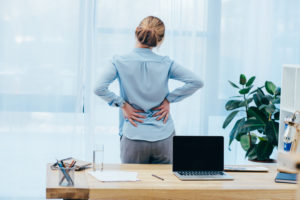
What is lumbar spinal stenosis?
The lumbar spine is the spinal segment that comprises the vertebrae and discs of the low back. Lumbar spinal stenosis is the term that describes narrowing in the spinal canal within this low segment of the spine (the low back). Lumbar spinal stenosis usually follows the growth of tissue or bone into the spinal canal. The result of this growth is nerve impingement or pressure on the nerves that exit the lower spine.
What causes lumbar spinal stenosis?
Ultimately, spinal stenosis is the result of wear and tear on the vertebra and intravertebral discs. In one instance, narrowing may be caused by degeneration referred to as degenerative disc disease. Another common origin is osteoarthritis, which can lead to bone spurs that intrude on the space in the spinal canal. Stenosis can also relate to a spinal injury, abnormal growths or tumors, and other factors.
Symptoms of Lumbar Spinal Stenosis
Common symptoms of lumbar spinal stenosis include:
- Chronic low back pain
- Stiffness in the legs
- Cramping in the buttocks or legs or a sensation of weakness or numbness in the lower extremities
- Severe lumbar spinal stenosis may affect bladder or bowel control
Treating Lumbar Spinal Stenosis
Several treatment options exist to reduce the effects of lumbar spinal stenosis. Whenever possible, doctors attempt non-surgical modalities first. These include the use of anti-inflammatory or pain relief medications, steroid injections to reduce inflammation, and physical therapy. If conservative approaches do not sufficiently minimize pain and improve quality of life, surgery may be considered.
Learn more about the surgical treatment of lumbar spinal stenosis or schedule an appointment by contacting our NYC office at 212-606-1004. We are here to help you recapture optimal comfort and quality of living.


